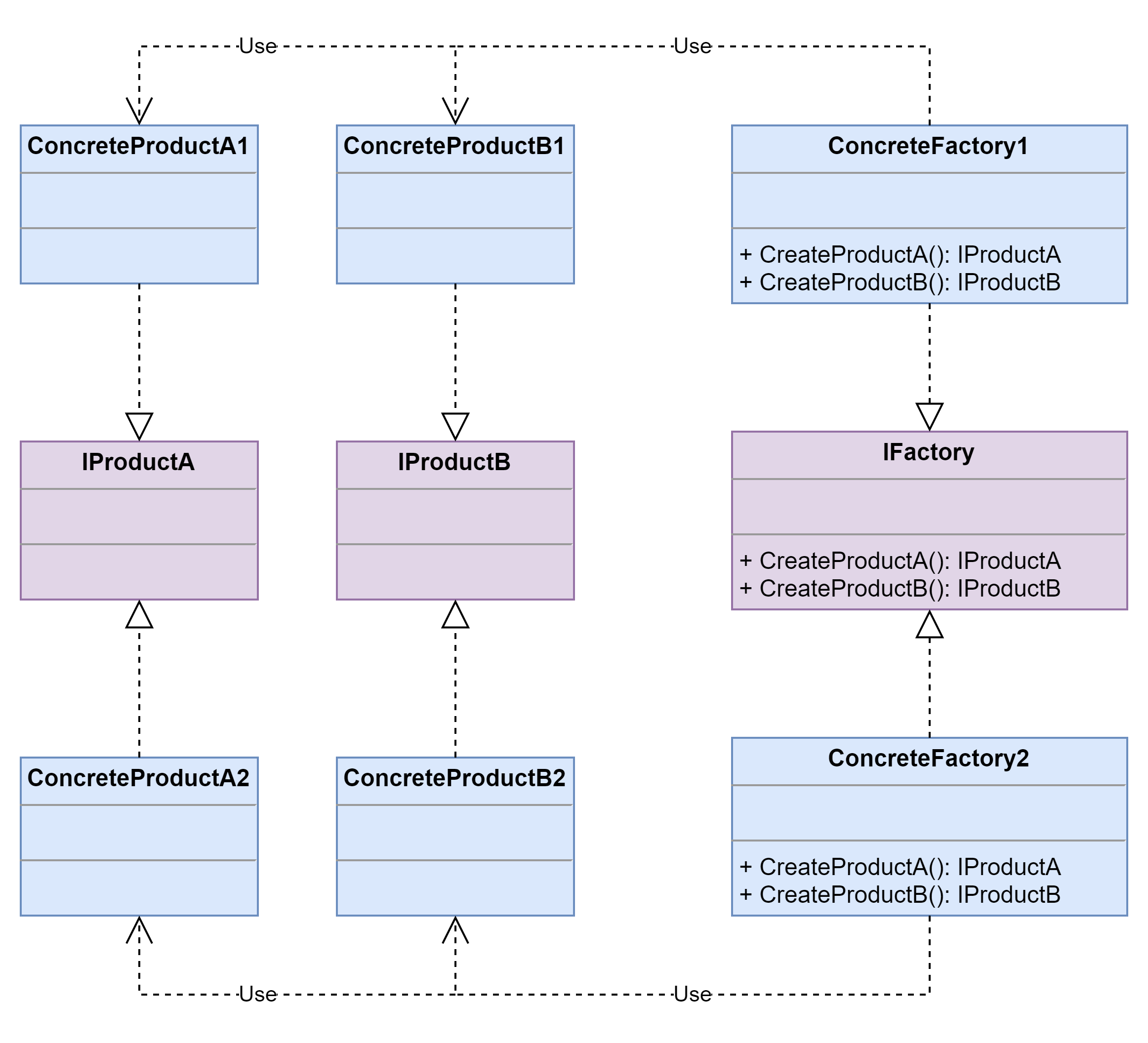抽象工厂模式 (Abstract Factory Pattern)
提供一个创建一系列相关或相互依赖对象的接口,而无须指定它们具体的类。抽象工厂模式又称为Kit模式,它是一种对象创建型模式。
结构图
- IFactory(抽象工厂):它声明了一组用于创建一族产品的方法,每一个方法对应一种产品。
- ConcreteFactory(具体工厂):它实现了在抽象工厂中声明的创建产品的方法,生成一组具体产品,这些产品构成了一个产品族,每一个产品都位于某个产品等级结构中。
- IProduct(抽象产品):它为每种产品声明接口,在抽象产品中声明了产品所具有的业务方法。
- ConcreteProduct(具体产品):它定义具体工厂生产的具体产品对象,实现抽象产品接口中声明的业务方法。
示例
using System;
namespace DesignPatterns.AbstractFactor
{
// The Abstract Factory interface declares a set of methods that return
// different abstract products. These products are called a family and are
// related by a high-level theme or concept. Products of one family are
// usually able to collaborate among themselves. A family of products may
// have several variants, but the products of one variant are incompatible
// with products of another.
public interface IAbstractFactory
{
IAbstractProductA CreateProductA();
IAbstractProductB CreateProductB();
}
// Concrete Factories produce a family of products that belong to a single
// variant. The factory guarantees that resulting products are compatible.
// Note that signatures of the Concrete Factory's methods return an abstract
// product, while inside the method a concrete product is instantiated.
class ConcreteFactory1 : IAbstractFactory
{
public IAbstractProductA CreateProductA()
{
return new ConcreteProductA1();
}
public IAbstractProductB CreateProductB()
{
return new ConcreteProductB1();
}
}
// Each Concrete Factory has a corresponding product variant.
class ConcreteFactory2 : IAbstractFactory
{
public IAbstractProductA CreateProductA()
{
return new ConcreteProductA2();
}
public IAbstractProductB CreateProductB()
{
return new ConcreteProductB2();
}
}
// Each distinct product of a product family should have a base interface.
// All variants of the product must implement this interface.
public interface IAbstractProductA
{
string UsefulFunctionA();
}
// Concrete Products are created by corresponding Concrete Factories.
class ConcreteProductA1 : IAbstractProductA
{
public string UsefulFunctionA()
{
return "The result of the product A1.";
}
}
class ConcreteProductA2 : IAbstractProductA
{
public string UsefulFunctionA()
{
return "The result of the product A2.";
}
}
// Here's the the base interface of another product. All products can
// interact with each other, but proper interaction is possible only between
// products of the same concrete variant.
public interface IAbstractProductB
{
// Product B is able to do its own thing...
string UsefulFunctionB();
// ...but it also can collaborate with the ProductA.
//
// The Abstract Factory makes sure that all products it creates are of
// the same variant and thus, compatible.
string AnotherUsefulFunctionB(IAbstractProductA collaborator);
}
// Concrete Products are created by corresponding Concrete Factories.
class ConcreteProductB1 : IAbstractProductB
{
public string UsefulFunctionB()
{
return "The result of the product B1.";
}
// The variant, Product B1, is only able to work correctly with the
// variant, Product A1. Nevertheless, it accepts any instance of
// AbstractProductA as an argument.
public string AnotherUsefulFunctionB(IAbstractProductA collaborator)
{
var result = collaborator.UsefulFunctionA();
return $"The result of the B1 collaborating with the ({result})";
}
}
class ConcreteProductB2 : IAbstractProductB
{
public string UsefulFunctionB()
{
return "The result of the product B2.";
}
// The variant, Product B2, is only able to work correctly with the
// variant, Product A2. Nevertheless, it accepts any instance of
// AbstractProductA as an argument.
public string AnotherUsefulFunctionB(IAbstractProductA collaborator)
{
var result = collaborator.UsefulFunctionA();
return $"The result of the B2 collaborating with the ({result})";
}
}
// The client code works with factories and products only through abstract
// types: AbstractFactory and AbstractProduct. This lets you pass any
// factory or product subclass to the client code without breaking it.
class Client
{
public void Main()
{
// The client code can work with any concrete factory class.
Console.WriteLine("Client: Testing client code with the first factory type...");
ClientMethod(new ConcreteFactory1());
Console.WriteLine();
Console.WriteLine("Client: Testing the same client code with the second factory type...");
ClientMethod(new ConcreteFactory2());
}
public void ClientMethod(IAbstractFactory factory)
{
var productA = factory.CreateProductA();
var productB = factory.CreateProductB();
Console.WriteLine(productB.UsefulFunctionB());
Console.WriteLine(productB.AnotherUsefulFunctionB(productA));
}
}
class Program
{
static void Main(string[] args)
{
new Client().Main();
}
}
}运行结果
1
2
3
4
5
6
7
Client: Testing client code with the first factory type...
The result of the product B1.
The result of the B1 collaborating with the (The result of the product A1.)
Client: Testing the same client code with the second factory type...
The result of the product B2.
The result of the B2 collaborating with the (The result of the product A2.)
总结
抽象工厂模式是工厂方法模式的进一步延伸,由于它提供了功能更为强大的工厂类并且具备较好的可扩展性,在软件开发中得以广泛应用,尤其是在一些框架和API类库的设计中,例如在Java语言的AWT(抽象窗口工具包)中就使用了抽象工厂模式,它使用抽象工厂模式来实现在不同的操作系统中应用程序呈现与所在操作系统一致的外观界面。抽象工厂模式也是在软件开发中最常用的设计模式之一。
优点
- 抽象工厂模式隔离了具体类的生成,使得客户并不需要知道什么被创建。由于这种隔离,更换一个具体工厂就变得相对容易,所有的具体工厂都实现了抽象工厂中定义的那些公共接口,因此只需改变具体工厂的实例,就可以在某种程度上改变整个软件系统的行为。
- 当一个产品族中的多个对象被设计成一起工作时,它能够保证客户端始终只使用同一个产品族中的对象。
- 增加新的产品族很方便,无须修改已有系统,符合“开闭原则”。
缺点
增加新的产品等级结构麻烦,需要对原有系统进行较大的修改,甚至需要修改抽象层代码,这显然会带来较大的不便,违背了“开闭原则”。
适用场景
- 一个系统不应当依赖于产品类实例如何被创建、组合和表达的细节,这对于所有类型的工厂模式都是很重要的,用户无须关心对象的创建过程,将对象的创建和使用解耦。
- 系统中有多于一个的产品族,而每次只使用其中某一产品族。可以通过配置文件等方式来使得用户可以动态改变产品族,也可以很方便地增加新的产品族。
- 属于同一个产品族的产品将在一起使用,这一约束必须在系统的设计中体现出来。同一个产品族中的产品可以是没有任何关系的对象,但是它们都具有一些共同的约束,如同一操作系统下的按钮和文本框,按钮与文本框之间没有直接关系,但它们都是属于某一操作系统的,此时具有一个共同的约束条件:操作系统的类型。
- 产品等级结构稳定,设计完成之后,不会向系统中增加新的产品等级结构或者删除已有的产品等级结构。
This post is licensed under CC BY 4.0 by the author.
